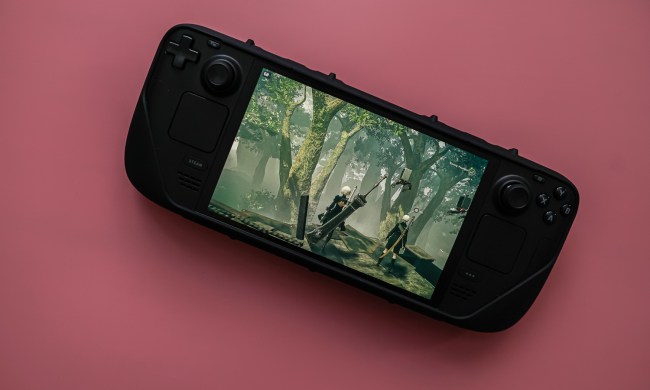Valve’s early build of the Steam Controller shows promise, but we still have plenty of questions about the feel and how the final design will come together.
There are a few requirements for a computer to call itself a Steam Machine. First, of course, it must have the blessing of Valve. Then, it must have the ability to run SteamOS, the Linux-based operating system that partly defines the Steam experience for the living room (think Steam’s TV-friendly Big Picture mode). Finally, to be a Steam Machine, the system must use the new Steam Controller, which will come included with each new Steam Machine and also, at some point, be sold separately. We had the chance to play with the Steam Controller, and can confirm that it is more than just a new take on an old idea. It is, in fact, fundamentally different from interface methods that we’ve seen before.
The Steam Controller is still in development, but the differences that set it apart even now are for better and for worse.
The first, obvious change is to the thumbsticks – or lack thereof. In the place of where the twin thumbsticks would typically be on a standard console-style gamepad are two circular, touch-sensitive trackpads. These aren’t just replacements though. In function, they are closer to the integrated mouse you would find on a laptop. It requires a different type of movement than what is required for a thumbstick. Rather than forcefully pushing the stick in the direction you intend to move, the trackpad requires smooth, light movements.
The controller also features haptic feedback, but it’s unlike what’s featured in most gamepads. Rather than using rumble motors, the Steam Controllers click. It shakes as if a tiny, controlled marble is loose inside the controller, bouncing from side to side with your every movement. In this sense, the haptic motors feel more fine-tuned than the current-gen controllers, but they may not be as powerful. It’s hard to tell, since the design isn’t finalized, and likely won’t be until later in 2014.
The rest of the controller is similarly overhauled. Three bars appear on the bottom of the front face of the controller. The buttons are all mappable, but two smaller buttons on the sides are equatable to a “Start” and “Select” button, with the right/Start bringing up the menu, and the left/Select button bringing up a keyboard. The keyboard is then controlled by the left trackpad. Sliding your thumb around the circle that appears brings up a set of letters in each angle of a radial menu. Select the set with the left trackpad, then choose which letter in the set you want with the right trackpad. Pushing down on the trackpad selects the letter, and the other buttons act as augmenters to make things like capital letters. The center bar, the longest of the three (picture a miniature space bar), opens a web browser.
The center of the controller features four equal-sized, square buttons, with four more, smaller, curved buttons bordering them. The shoulders have two buttons on each side, just like a standard gamepad. On the very back where you normally rest your fingers while gripping a gamepad, there are two more paddle-style buttons – one on each side.
Of all the unique aspects of the Steam Controller, these buttons are perhaps the most universally useful. Typically your thumbs do all the work with controllers, while your fingers rest on the back of the controller, with the exception of your index (and possibly middle fingers), which are used for shoulder buttons. While the rest of the controller is arguably a different way at looking at the traditional controller, the buttons on the back are an idea all controllers can and should consider. Well, maybe for the next-next-gen.
The Steam Controller is still in development, but the differences that set it apart even now are for better and for worse. It requires you to relearn what for most of us is a lifetime of muscle memory. The upside is that it may offer more precision than any controller before it thanks to the dual trackpads, but the placement of the middle buttons will require you to move your fingers in a new, potentially awkward way. Precision might improve as a result, but there’s going to be a learning curve as you get used to accessing a whole new array of buttons. It’s important to remember that this is still a prototype, and the final design has yet to be confirmed. When it is, we look forward to trying it out.
Highs
- Dual trackpads promise more precision
- Haptic feedback differs from conventional console controllers
Lows
- The re-learning process could be a slow one for longtime gamers
- The design is early, and still subject to change




